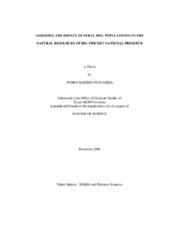| dc.contributor.advisor | Lopez, Roel R. | |
| dc.creator | Chavarria, Pedro Mazier | |
| dc.date.accessioned | 2010-01-14T23:56:36Z | |
| dc.date.accessioned | 2010-01-16T01:13:45Z | |
| dc.date.available | 2010-01-14T23:56:36Z | |
| dc.date.available | 2010-01-16T01:13:45Z | |
| dc.date.created | 2006-12 | |
| dc.date.issued | 2009-05-15 | |
| dc.identifier.uri | https://hdl.handle.net/1969.1/ETD-TAMU-1212 | |
| dc.description.abstract | The Big Thicket National Preserve (BTNP) is a unit of the National Park Service
whose mission prioritizes conservation of its wildlands in the United States. One threat
to natural resources of the BTNP has been impacts associated with feral hog (Sus scrofa)
activities. Population numbers of this non-native game species have increased
throughout Texas, including areas within the preserve. Recreational hunting permitted
by the BTNP has served as a means of controlling hog numbers, although the reported
amounts of hog damage to park resources appear to have increased in recent years.
Population reduction of feral hogs and mitigation of their impacts require research that
documents and validates feral hog impacts on park resources. Here, I evaluated (1)
population trends of feral hogs for the past 20 years via data from hunter-card surveys
and track-counts, and (2) feral hog impacts on native vegetation for 3 management units
of the BTNP.
Results from my analysis suggest a nearly 3-fold increase in hog numbers
throughout the preserve since 1981. The overall damage to vegetation from hog rooting
or wallowing averaged to 28% among the 3 units of the BTNP. Landscape features such
as topography, soil moisture, soil type, and dominant vegetative cover types were used to predict hog damage. Floodplains had the most damage in the Big Sandy unit (45%),
while flatlands were mostly impacted in the Turkey Creek unit (46%), and uplands in the
Lance Rosier unit (32%). Vegetative cover was an important variable in explaining
variation in hog damage throughout the 3 units of the preserve. Impacts were more
widespread across different vegetative strata than previously believed. Study results also
support the premise that hog damage in the BTNP parallels the increase in hog
abundance over the past 20 years. A more aggressive program for population reduction
of feral hogs and mitigation of their impacts is recommended for the BTNP to continue
to meet its legal mandates for conservation. | en |
| dc.format.medium | electronic | en |
| dc.format.mimetype | application/pdf | |
| dc.language.iso | en_US | |
| dc.subject | feral hog | en |
| dc.subject | National Park Service | en |
| dc.subject | rooting | en |
| dc.subject | stratified sampling | en |
| dc.title | Assessing the impact of feral hog populations on the natural resources of Big Thicket National Preserve | en |
| dc.type | Book | en |
| dc.type | Thesis | en |
| thesis.degree.department | Wildlife and Fisheries Sciences | en |
| thesis.degree.discipline | Wildlife and Fisheries Sciences | en |
| thesis.degree.grantor | Texas A&M University | en |
| thesis.degree.name | Master of Science | en |
| thesis.degree.level | Masters | en |
| dc.contributor.committeeMember | Bowser, Gillian | |
| dc.contributor.committeeMember | Kyle, Gerard T. | |
| dc.contributor.committeeMember | Silvy, Nova J. | |
| dc.type.genre | Electronic Thesis | en |
| dc.type.material | text | en |
| dc.format.digitalOrigin | born digital | en |


